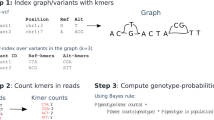Abstract
Analysis of genetic variation using graph structures is an emerging paradigm of genomics. However, defining genetic sites on sequence graphs remains an open problem. Paten’s invention of the ultrabubble and snarl, special subgraphs of sequence graphs which can identified with efficient algorithms, represents important first step to segregating graphs into genetic sites. We extend the theory of ultrabubbles to a special subclass where every detail of the ultrabubble can be described in a series and parallel arrangement of genetic sites. We furthermore introduce the concept of bundle structures, which allows us to recognize the graph motifs created by additional combinations of variation in the graph, including but not limited to runs of abutting single nucleotide variants. We demonstrate linear-time identification of bundles in a bidirected graph. These two advances build on initial work on ultrabubbles in bidirected graphs, and define a more granular concept of genetic site.
Access this chapter
Tax calculation will be finalised at checkout
Purchases are for personal use only
Similar content being viewed by others
Notes
- 1.
It is on bidirected graphs.
References
1000 Genomes Project Consortium, et al.: A global reference for human genetic variation. Nature 526(7571), 68–74 (2015)
Beyer, W.: Sequence tube maps (2016). https://github.com/wolfib/sequenceTubeMap
Brankovic, L., Iliopoulos, C.S., Kundu, R., Mohamed, M., Pissis, S.P., Vayani, F.: Linear-time superbubble identification algorithm for genome assembly. Theor. Comput. Sci. 609(Pt. 2), 374–383 (2016). http://www.sciencedirect.com/science/article/pii/S0304397515009147
Danecek, P., Auton, A., Abecasis, G., Albers, C.A., Banks, E., DePristo, M.A., Handsaker, R.E., Lunter, G., Marth, G.T., Sherry, S.T., et al.: The variant call format and vcftools. Bioinformatics 27(15), 2156–2158 (2011)
Duffin, R.: Topology of series-parallel networks. J. Math. Anal. Appl. 10(2), 303–318 (1965). http://www.sciencedirect.com/science/article/pii/0022247X65901253
Medvedev, P., Brudno, M.: Maximum likelihood genome assembly. J. Comput. Biol. 16(8), 1101–1116 (2009)
Novak, A.M., Hickey, G., Garrison, E., Blum, S., Connelly, A., Dilthey, A., Eizenga, J., Elmohamed, M.A.S., Guthrie, S., Kahles, A., Keenan, S., Kelleher, J., Kural, D., Li, H., Lin, M.F., Miga, K., Ouyang, N., Rakocevic, G., Smuga-Otto, M., Zaranek, A.W., Durbin, R., McVean, G., Haussler, D., Paten, B.: Genome graphs. bioRxiv (2017). http://biorxiv.org/content/early/2017/01/18/101378
Onodera, T., Sadakane, K., Shibuya, T.: Detecting superbubbles in assembly graphs. In: Darling, A., Stoye, J. (eds.) WABI 2013. LNCS, vol. 8126, pp. 338–348. Springer, Heidelberg (2013). doi:10.1007/978-3-642-40453-5_26
Paten, B., Novak, A.M., Garrison, E., Hickey, G.: Superbubbles, ultrabubbles and cacti. bioRxiv (2017). http://biorxiv.org/content/early/2017/01/18/101493
Sudmant, P.H., Rausch, T., Gardner, E.J., Handsaker, R.E., Abyzov, A., Huddleston, J., Zhang, Y., Ye, K., Jun, G., Fritz, M.H.Y., et al.: An integrated map of structural variation in 2,504 human genomes. Nature 526(7571), 75–81 (2015)
Sung, W.K., Sadakane, K., Shibuya, T., Belorkar, A., Pyrogova, I.: An o(m log m)-time algorithm for detecting superbubbles. IEEE/ACM Trans. Comput. Biol. Bioinform. 12(4), 770–777. https://doi.org/10.1109/TCBB.2014.2385696
Valdes, J., Tarjan, R.E., Lawler, E.L.: The recognition of series parallel digraphs. SIAM J. Comput. 11(2), 298–313 (1982). http://dx.doi.org/10.1137/0211023
Zerbino, D.R., Birney, E.: Velvet: algorithms for de novo short read assembly using de bruijn graphs. Genome Res. 18(5), 821–829 (2008)
Acknowledgements
Y.R. is supported by a Howard Hughes Medical Institute Medical Research Fellowship. This work was also supported by the National Human Genome Research Institute of the National Institutes of Health under Award Number 5U54HG007990 and grants from the W.M. Keck foundation and the Simons Foundation. The content is solely the responsibility of the authors and does not necessarily represent the official views of the National Institutes of Health. We thank Wolfgang Beyer for his visualizations of 1000 Genomes data in a variation graph.
Author information
Authors and Affiliations
Corresponding author
Editor information
Editors and Affiliations
Rights and permissions
Copyright information
© 2017 Springer International Publishing AG
About this paper
Cite this paper
Rosen, Y., Eizenga, J., Paten, B. (2017). Describing the Local Structure of Sequence Graphs. In: Figueiredo, D., Martín-Vide, C., Pratas, D., Vega-Rodríguez, M. (eds) Algorithms for Computational Biology. AlCoB 2017. Lecture Notes in Computer Science(), vol 10252. Springer, Cham. https://doi.org/10.1007/978-3-319-58163-7_2
Download citation
DOI: https://doi.org/10.1007/978-3-319-58163-7_2
Published:
Publisher Name: Springer, Cham
Print ISBN: 978-3-319-58162-0
Online ISBN: 978-3-319-58163-7
eBook Packages: Computer ScienceComputer Science (R0)




